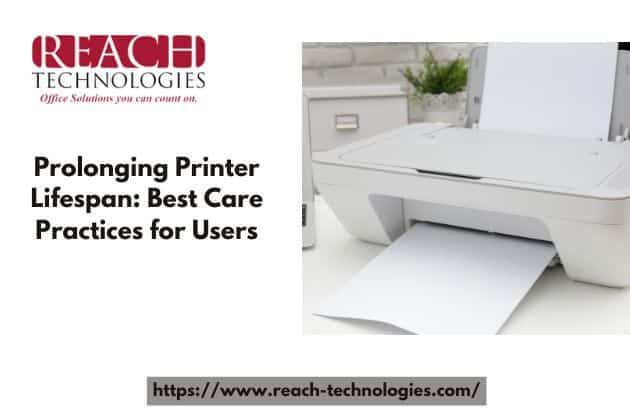Understanding the Importance of Printer Longevity
In today’s technology-driven workplaces, printers remain a vital component of daily operations. Whether it’s a bustling corporate office, a small business, or a home setup, ensuring the maximum lifespan of a printer is essential to controlling costs, minimizing downtime, and maintaining productivity. Prolonging the life of your printer requires a combination of regular maintenance, strategic usage, and proactive care practices that prevent wear and tear.
Routine Maintenance: The Foundation of Printer Longevity

1. Regular Cleaning for Optimal Performance
Dust, debris, and toner residue can accumulate in and around the printer, leading to jams, poor print quality, and eventual hardware failure. To prevent this:
-
Clean the exterior with a soft, dry cloth weekly.
-
Use canned air to blow dust from vents and paper trays.
-
Wipe the rollers gently with a lint-free cloth and isopropyl alcohol.
-
Clean the print heads according to the manufacturer’s recommendations, especially in inkjet printers.
Regular cleaning not only enhances performance but also protects sensitive internal components.
2. Scheduled Internal Maintenance Checks
Most modern printers include built-in maintenance tools. We recommend:
-
Running self-cleaning cycles monthly to prevent ink clogs.
-
Checking and aligning print heads to ensure consistent quality.
-
Inspecting belts, gears, and moving parts for signs of wear.
-
Updating firmware regularly to benefit from security patches and performance enhancements.
These actions help avoid costly repairs and extend the useful life of the printer.
Smart Usage Practices That Preserve Printer Health
3. Use Genuine Consumables and Supplies
While third-party cartridges and toner may seem cost-effective, they often lead to:
-
Ink leaks or toner spillage
-
Clogged nozzles and inconsistent print quality
-
Damage to internal components due to incompatible chemical compositions
We strongly advise using OEM (Original Equipment Manufacturer) cartridges, toner, and maintenance kits to protect your printer’s integrity and warranty.
4. Match the Printer to the Workload
Overworking a small office printer in a high-volume environment leads to rapid degradation. When choosing a printer, always:
-
Assess monthly duty cycle ratings and match them to actual output needs.
-
Use industrial or enterprise-grade printers for heavy, continuous workloads.
-
Rotate between multiple printers in high-traffic environments to distribute usage evenly.
This prevents overheating and prolongs motor and component life.
5. Keep the Printer in a Controlled Environment
Environmental conditions can significantly affect printer performance and durability. To maximize longevity:
-
Store the printer in a cool, dry place away from direct sunlight.
-
Avoid areas with high humidity, which can cause paper to curl or jam.
-
Ensure proper ventilation around the printer to avoid heat buildup.
Stability in temperature and humidity ensures consistent functioning and protects internal mechanisms.
Paper Handling Best Practices to Avoid Jams and Damage
6. Use High-Quality, Compatible Paper
The wrong type of paper can cause frequent jams, misfeeds, and damage to rollers. To prevent these issues:
-
Always select paper that matches the printer specifications for weight and size.
-
Avoid low-quality or recycled paper with high dust content.
-
Store paper in its original packaging to maintain moisture balance.
Good paper management ensures smoother operation and reduces maintenance needs.
7. Load Paper Correctly and Avoid Overfilling
Incorrect paper loading is a leading cause of mechanical failures. To ensure proper loading:
-
Align paper neatly in the tray without bending edges.
-
Use paper guides to prevent slanting and misalignment.
-
Avoid overfilling trays, which increases the risk of jams.
Adhering to these practices ensures smooth feeding and minimizes wear on internal rollers.
Print Job Management to Reduce Mechanical Stress
8. Avoid Interrupting Print Jobs Mid-Cycle
Halting a print job while it’s in progress can confuse the printer’s logic board and lead to paper misfeeds or software errors. Ensure:
-
All print jobs are allowed to complete without interruptions.
-
Network printers are not overloaded with simultaneous print requests.
Stable workflows minimize stress on the print engine and improve overall reliability.
9. Print in Draft Mode When High Quality Isn’t Needed
For everyday internal documents, using draft mode reduces the amount of ink used and increases printing speed, which contributes to:
-
Less stress on print heads
-
Reduced ink consumption
-
Longer-lasting cartridges and components
Reserving high-resolution printing for important materials preserves the printer’s mechanisms.
Software, Drivers, and Connectivity Practices
10. Keep Printer Drivers Updated
Outdated drivers can cause:
-
Compatibility issues with operating systems
-
Malfunctions in print processing and spool errors
-
Inaccurate commands sent to the printer hardware
Always download driver updates directly from the manufacturer’s website to maintain full functionality.
11. Secure Printer Connections
Unstable network connections can lead to:
-
Incomplete jobs
-
Communication errors
-
Wasted resources due to retries
Use wired connections whenever possible for network printers and ensure firmware encryption protocols are up to date to protect data and optimize throughput.
Preventive Care Through Managed Print Services
12. Partner with a Managed Print Service Provider
A Managed Print Services (MPS) provider offers:
-
Remote monitoring of toner and maintenance needs
-
Proactive replacement of worn-out parts
-
Automated diagnostics and reporting
-
Predictive servicing schedules
This ensures your printer fleet is always in top shape, reducing the risk of downtime and extending lifespan.
Avoid Common User Mistakes That Shorten Printer Life
13. Don’t Turn the Printer On and Off Frequently
Frequent power cycling wears out mechanical parts and degrades internal systems. Instead:
-
Leave the printer in sleep mode when not in use.
-
Power it off only during extended periods of inactivity.
This protects internal circuits and extends the life of fusers and print heads.
14. Handle Internal Components with Care
When replacing cartridges or clearing jams:
-
Avoid touching sensitive parts like the drum unit or transfer belt.
-
Follow instructions carefully to prevent misalignment or contamination.
Proper handling ensures that parts function correctly and last longer.
Conclusion: Extend Your Printer’s Lifespan with Proactive Care
By implementing these printer care best practices, users can significantly extend the life of their devices, improve performance, and minimize the total cost of ownership. Whether in a home, office, or enterprise environment, proper usage, regular maintenance, and smart supply choices all contribute to the longevity of your printer.
Take care of your printer, and it will take care of your documents—efficiently, reliably, and for years to come.
